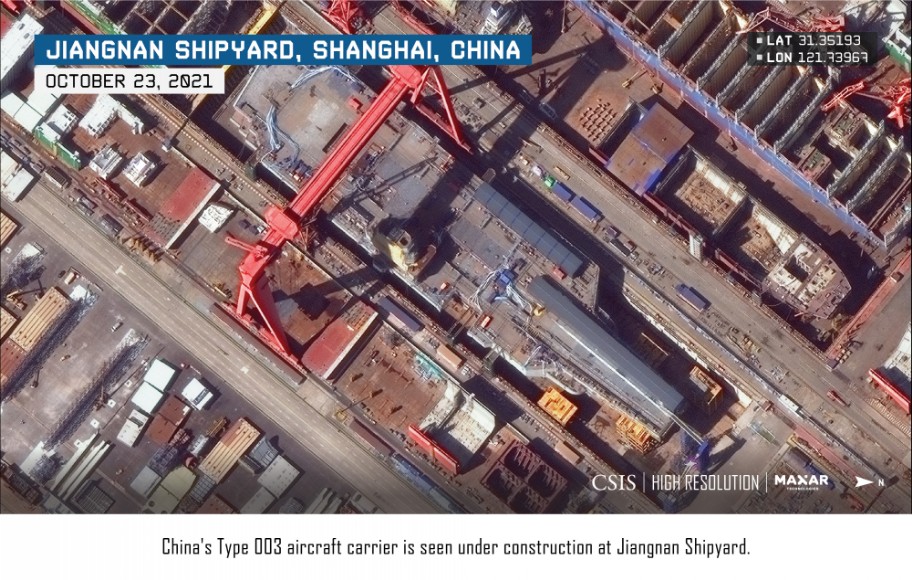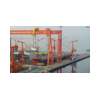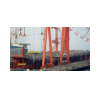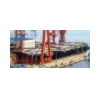China: Next Aircraft Carriers
Aircraft Carriers
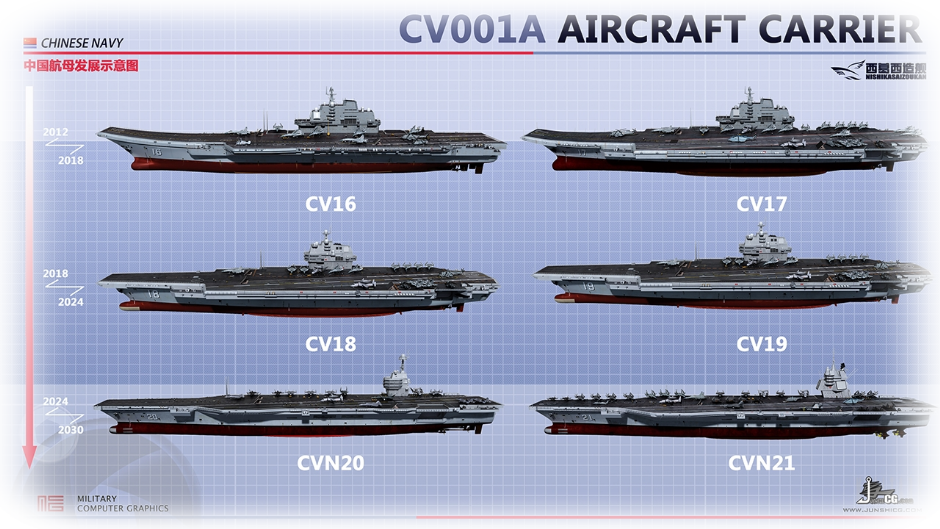
![]() The first built-in-China aircraft carrier has completed a third sea trial but needs more time to reach combat readiness, with the coronavirus pandemic taking a toll on testing schedules, according to military observers.
The first built-in-China aircraft carrier has completed a third sea trial but needs more time to reach combat readiness, with the coronavirus pandemic taking a toll on testing schedules, according to military observers.
The Shandong finished a 23-day voyage in the Bohai Sea and returned to its home port of Dalian in the northeast province of Liaoning on Sunday.
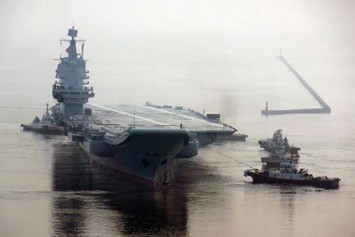 The trial was completed just a few days before the first anniversary of the carrier's commissioning and amid reports that the vessel might reach initial operational capability (IOC), the basic level of combat readiness, as early as the start of 2021.
The trial was completed just a few days before the first anniversary of the carrier's commissioning and amid reports that the vessel might reach initial operational capability (IOC), the basic level of combat readiness, as early as the start of 2021."Whether the Shandong can complete all tests and meet IOC in the beginning of next year will depend on the pandemic."
Hong Kong-based, pro-Beijing newspaper Wen Wei Po reported on Monday that commercial satellite images showed for the first time, a submarine sailing near the Shandong during the trial.
Observers said this was probably part of training to improve the carrier's ability to give coverage to the country's nuclear-armed ballistic submarines.
Name: CV-17 Shandong
Namesake: Shandong Province
Builder: Dalian Shipbuilding Industry
Laid down: March 2015
Launched: 26 April 2017
Completed: 25 April 2018
Commissioned: 17 December 2019
Status: In active service
General characteristics
Class and type: Type 002 (variant of Kuznetsov-class aircraft carrier)
Displacement: Standard Load 55,000 tons, Full Load 66,000 to 70,000 tons [1][2][3]
Length: 315 m (1,033 ft)
Beam: 75 metres (246 ft)
Propulsion: Conventional steam turbines, 4 shafts
Speed: 31 knots (36 mph; 57 km/h)
Sensors and processing systems:
(Type 346 radar) Type 346A S-band AESA
Type 382 Radar
Armament:
3 × Type 1130 CIWS
3 × HQ-10 (18 Cell Missile system)
Aircraft carried:
44 total aircraft including:
32 Shenyang J-15
8 Changhe Z-18
4 Harbin Z-9
Wikipedia-Defense News
One of the
other significant developments in Chinese carrier progress is the pace of work
on carrier 003 at Jiangnan shipyard in Shanghai. As now established, 003 will
be the Chinese Navy’s first CATOBAR carrier, and while it will remain
conventionally powered, it will likely be significantly larger than Liaoning
and Shandong, with a full displacement commonly cited at some 85,000 tons.
As long
expected, the large super-block modules of 003 were moved from their initial
fabrication area once they reached a sufficient stage of completion – this
movement of modules occurred in mid-May 2020, whereupon they were transported
to the staging area adjacent to drydock four in the same shipyard. One surprise
of note was how the modules appear to have been moved overland rather than via
the dedicated new submersible barge, which itself was launched on May 18. It is
possible that the timing for 003’s construction made it such that it was
prudent to move its super-blocks without the need for the barge. That said, it
is very likely that future carriers built at Jiangnan will use the new barge
for intra-yard transport. With a length of 250 meters, a beam of 60 meters, and
a full load of 32,000 tons, and equipped with tracks matching the module
fabrication facility, there are only so many roles this barge could fulfill.
 In
subsequent months, publicly attainable satellite imagery has followed the
mating of 003’s super-blocks in drydock. The first modules were moved into the
drydock around July 23, with progressively better satellite and aerial
photographs documenting progress in the weeks following. The most recent high
quality pictures, taken from the air in early September, show almost all of the
super-blocks of the keel and base hull of the ship residing in the drydock,
seemingly with only the front-most part of the bow yet to be seen. Work on the
carrier has been accompanied by some media and think tank interest,
characterized by varying degrees of accuracy.
In
subsequent months, publicly attainable satellite imagery has followed the
mating of 003’s super-blocks in drydock. The first modules were moved into the
drydock around July 23, with progressively better satellite and aerial
photographs documenting progress in the weeks following. The most recent high
quality pictures, taken from the air in early September, show almost all of the
super-blocks of the keel and base hull of the ship residing in the drydock,
seemingly with only the front-most part of the bow yet to be seen. Work on the
carrier has been accompanied by some media and think tank interest,
characterized by varying degrees of accuracy.Attempts
have been made to estimate the length of the ship by measuring the individual
hull super-blocks, and while the range of numbers produced are subject to error,
it is widely accepted at this stage that even without the bow module visible,
the total cumulative hull/waterline length is nearly 300 meters, already almost
as long as the total 305-meter length (including flight deck) of the carriers
Liaoning and Shandong. In fact, the sheer size of 003’s potential waterline
length and beam (the latter being 40 meters at its widest point) has led some
parts of the PLA-watching community to question if past rumors of 85,000 tons
full displacement may have been an underestimate or perhaps reflective of an
older configuration or design. It was known in earlier years that 003 was
originally intended to field steam catapults rather than electromagnetic (EM)
catapults, so it is plausible that changes in 003’s design and displacement may
have occurred alongside the decision to equip it with EM catapults.
At this
point in time, work will proceed for the super-blocks to be fully mated
together including installation of the bow module, at which point additional
modules forming the upper decks, hangar decks and flight deck will gradually be
added, until the island is finally installed. Afterwards, the ship will be
launched. Current projections set that for early to mid 2022 at the earliest.
After launch, the ship will be fitted out with its relevant mission systems,
including its much awaited EM catapults. Only then will it proceed to sea
trials and enter service, under the expected pennant number CV-18.
Numbers and
Nukes
The visible
progress on carrier 003 and its impending launch leads observers naturally to
wonder what will follow. For many years, it has been speculated that the
Chinese Navy will seek to field at least six aircraft carriers, which has
gained prominence in mainstream commentary thanks to some media outlets suggesting
the PLAN will seek six carriers by 2035. It is also widely accepted in the PLA
watching community that the final goal for PLAN carrier development is large,
nuclear-powered supercarriers not dissimilar to US Nimitz- and Ford-class CVNs,
but the timetable for their emergence is not known.
With two
shipyards (Dalian and Jiangnan) proving they are capable of constructing
carriers, the question now becomes when the next Chinese carrier will emerge
after 003. It is expected that additional carriers adopting the 003 design will
be built before the PLAN advances to a nuclear powered design, but it’s not
known how many 003 pattern carriers may be built. It is also not known if
further 003 pattern carriers will also be designated “003” or if the “00X” designation
represents successive carrier hulls rather than carrier designs.
Interestingly,
at least one Chinese-language PLA insider with an established long term track
record has himself dismissed foreign media expectations of “six carriers by
2035,” remarking that the Chinese Navy’s plans spoke of 10 or more carriers;
however, it is unclear when this would occur by, whether by 2035 or later. That
remarked carrier count represents proper aircraft carriers, not including the
previously discussed 076 assault carrier, which is spoken of as an amphibious
assault ship instead. Nevertheless, such numbers for future Chinese carriers
can rightly considered as fantastical and speculative at this stage. But with
both Dalian and Jiangnan demonstrating their ability to produce carriers, the
potential for dual shipyard carrier production now exists – and a decade ago in
2010 the idea of the PLAN fielding some 39 high end Aegis-type destroyers by
2024 would have seemed fantastical as well, so only time will tell.
What’s in a
Name?
From
mid-2019 to the second half of 2020, many disparate elements of the Chinese
Navy’s carrier development have continued to progress and come together.
However,
one phenomenon that seems to persist among some media outlets, authors, and
even think tanks, is confusion surrounding the proper designation of which
carriers are “002” versus “003.” Some media outlets continue to describe the
85,000 ton CATOBAR carrier being built at Jiangnan as “002” rather than 003.
This likely reflects the previous common assumption that CV-17 Shandong was
designated “001A.” However, the designation of CV-17 Shandong was definitively
settled on December 17, 2019, when the designation “002” was literally
plastered in bold red words on a giant plaque at the carrier’s commissioning
ceremony.
From the
perspective of journalistic, academic and professional accuracy, it is somewhat
jarring to see out-of-date and incorrect
designations still in use. The names of these carriers might not be overtly
consequential, but for the purposes of resolving confusion and creating
consistency, it is likely desirable for various commentators and authors to
acquaint themselves with the correct nomenclature.
The
Diplomat
